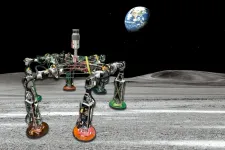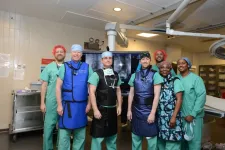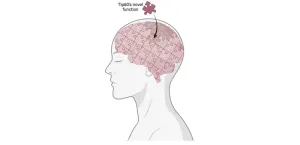(Press-News.org) When astronauts begin to build a permanent base on the moon, as NASA plans to do in the coming years, they’ll need help. Robots could potentially do the heavy lifting by laying cables, deploying solar panels, erecting communications towers, and building habitats. But if each robot is designed for a specific action or task, a moon base could become overrun by a zoo of machines, each with its own unique parts and protocols.
To avoid a bottleneck of bots, a team of MIT engineers is designing a kit of universal robotic parts that an astronaut could easily mix and match to rapidly configure different robot “species” to fit various missions on the moon. Once a mission is completed, a robot can be disassembled and its parts used to configure a new robot to meet a different task.
The team calls the system WORMS, for the Walking Oligomeric Robotic Mobility System. The system’s parts include worm-inspired robotic limbs that an astronaut can easily snap onto a base, and that work together as a walking robot. Depending on the mission, parts can be configured to build, for instance, large “pack” bots capable of carrying heavy solar panels up a hill. The same parts could be reconfigured into six-legged spider bots that can be lowered into a lava tube to drill for frozen water.
“You could imagine a shed on the moon with shelves of worms,” says team leader George Lordos, a PhD candidate and graduate instructor in MIT’s Department of Aeronautics and Astronautics (AeroAstro), in reference to the independent, articulated robots that carry their own motors, sensors, computer, and battery. “Astronauts could go into the shed, pick the worms they need, along with the right shoes, body, sensors and tools, and they could snap everything together, then disassemble it to make a new one. The design is flexible, sustainable, and cost-effective.”
Lordos’ team has built and demonstrated a six-legged WORMS robot. Last week, they presented their results at IEEE’s Aerospace Conference, where they also received the conference’s Best Paper Award.
MIT team members include Michael J. Brown, Kir Latyshev, Aileen Liao, Sharmi Shah, Cesar Meza, Brooke Bensche, Cynthia Cao, Yang Chen, Alex S. Miller, Aditya Mehrotra, Jacob Rodriguez, Anna Mokkapati, Tomas Cantu, Katherina Sapozhnikov, Jessica Rutledge, David Trumper, Sangbae Kim, Olivier de Weck, Jeffrey Hoffman, along with Aleks Siemenn, Cormac O’Neill, Diego Rivero, Fiona Lin, Hanfei Cui, Isabella Golemme, John Zhang, Jolie Bercow, Prajwal Mahesh, Stephanie Howe, and Zeyad Al Awwad, as well as Chiara Rissola of Carnegie Mellon University and Wendell Chun of the University of Denver.
Animal instincts
WORMS was conceived in 2022 as an answer to NASA’s Breakthrough, Innovative and Game-changing (BIG) Idea Challenge — an annual competition for university students to design, develop, and demonstrate a game-changing idea. In 2022, NASA challenged students to develop robotic systems that can move across extreme terrain, without the use of wheels.
A team from MIT’s Space Resources Workshop took up the challenge, aiming specifically for a lunar robot design that could navigate the extreme terrain of the moon’s South Pole — a landscape that is marked by thick, fluffy dust; steep, rocky slopes; and deep lava tubes. The environment also hosts “permanently shadowed” regions that could contain frozen water, which, if accessible, would be essential for sustaining astronauts.
As they mulled over ways to navigate the moon’s polar terrain, the students took inspiration from animals. In their initial brainstorming, they noted certain animals could conceptually be suited to certain missions: A spider could drop down and explore a lava tube, a line of elephants could carry heavy equipment while supporting each other down a steep slope, and a goat, tethered to an ox, could help lead the larger animal up the side of a hill as it transports an array of solar panels.
“As we were thinking of these animal inspirations, we realized that one of the simplest animals, the worm, makes similar movements as an arm, or a leg, or a backbone, or a tail,” says deputy team leader and AeroAstro graduate student Michael Brown. “And then the lightbulb went off: We could build all these animal-inspired robots using worm-like appendages.’”
Snap on, snap off
Lordos, who is of Greek descent, helped coin WORMS, and chose the letter “O” to stand for “oligomeric,” which in Greek signifies “a few parts.”
“Our idea was that, with just a few parts, combined in different ways, you could mix and match and get all these different robots,” says AeroAstro undergraduate Brooke Bensche.
The system’s main parts include the appendage, or worm, which can be attached to a body, or chassis, via a “universal interface block” that snaps the two parts together through a twist-and-lock mechanism. The parts can be disconnected with a small tool that releases the block’s spring-loaded pins.
Appendages and bodies can also snap into accessories such as a “shoe,” which the team engineered in the shape of a wok, and a LiDAR system that can map the surroundings to help a robot navigate.
“In future iterations we hope to add more snap-on sensors and tools, such as winches, balance sensors, and drills,” says AeroAstro undergraduate Jacob Rodriguez.
The team developed software that can be tailored to coordinate multiple appendages. As a proof of concept, the team built a six-legged robot about the size of a go-cart. In the lab, they showed that once assembled, the robot’s independent limbs worked to walk over level ground. The team also showed that they could quickly assemble and disassemble the robot in the field, on a desert site in California.
In its first generation, each WORMS appendage measures about 1 meter long and weighs about 20 pounds. In the moon’s gravity, which is about one-sixth that of Earth’s, each limb would weigh about 3 pounds, which an astronaut could easily handle to build or disassemble a robot in the field. The team has planned out the specs for a larger generation with longer and slightly heavier appendages. These bigger parts could be snapped together to build “pack” bots, capable of transporting heavy payloads.
“There are many buzz words that are used to describe effective systems for future space exploration: modular, reconfigurable, adaptable, flexible, cross-cutting, et cetera,” says Kevin Kempton, an engineer at NASA’s Langley Research Center, who served as a judge for the 2022 BIG Idea Challenge. “The MIT WORMS concept incorporates all these qualities and more.”
This research was supported, in part, by NASA, MIT, the Massachusetts Space Grant, the National Science Foundation, and the Fannie and John Hertz Foundation.
###
Written by Jennifer Chu, MIT News Office
END
Mix-and-match kit could enable astronauts to build a menagerie of lunar exploration bots
Robotic parts could be assembled into nimble spider bots for exploring lava tubes or heavy-duty elephant bots for transporting solar panels.
2023-03-14
ELSE PRESS RELEASES FROM THIS DATE:
Common dry cleaning chemical linked to Parkinson’s
2023-03-14
A common and widely used chemical may be fueling the rise of the world’s fastest growing brain condition – Parkinson’s disease. For the past 100 years, trichloroethylene (TCE) has been used to decaffeinate coffee, degrease metal, and dry clean clothes. It contaminates the Marine Corps base Camp Lejeune, 15 toxic Superfund sites in Silicon Valley, and up to one-third of groundwater in the U.S. TCE causes cancer, is linked to miscarriages and congenital heart disease, and is associated ...
Molecular component of caffeine may play a role in gut health
2023-03-14
Brigham researchers studying how and why certain cell types proliferate in the gut found that xanthine, which is found in coffee, tea and chocolate, may play a role in Th17 differentiation
Insights may help investigators better understand gut health and the development of conditions such as inflammatory bowel disease
The gut is home to a cast of microbes that influence health and disease. Some types of microorganisms are thought to contribute to the development of inflammatory conditions, such as inflammatory bowel disease (IBD), but the exact cascade of events that leads from microbes to immune cells to disease remains ...
Ochsner Health announces new Aortic Center; subscribes to cutting-edge imaging with Cydar Technology
2023-03-14
NEW ORLEANS, La. – Global death rates from aortic diseases have steadily increased over the past two decades. Studies show up to 8% of individuals will develop an aortic aneurysm during their lifetime, higher than rates of colon and lung cancer combined, and over 80% of ruptured aortic aneurysms cause sudden death.
To save lives and improve outcomes for patients with aortic disease of all kinds, Ochsner Health is excited to announce the establishment of The Ochsner Aortic Center. Outfitted with cutting-edge imaging technology that allows medical staff to make faster, easier, and safer decisions, this dedicated, comprehensive aortic center is now the ...
Aston Pharmacy School researchers develop new technique mixing oil and water to improve drug delivery
2023-03-14
A team of researchers from Aston University has developed a new technique that could be a game changer for the medical and drinks industries.
The technology enables insoluble drug/oil to be dissolved in water. The technique is novel because it doesn’t just mix the two together to make an emulsion, it makes oil soluble in water and has the potential to revolutionise a variety of medical treatments and improve drug delivery.
The technique was developed with Max Bio+ a spin out company founded by Professor Sunil Shah, a consultant ...
New guideline introduces recommendations for optimal timing of elective hip or knee arthroplasty
2023-03-14
ATLANTA — The American College of Rheumatology (ACR) and the American Association of Hip and Knee Surgeons (AAHKS) released a summary of its new guideline titled “the Optimal Timing of Elective Hip or Knee Arthroplasty for Patients with Symptomatic Moderate to Severe Osteoarthritis or Osteonecrosis Who Have Failed Nonoperative Therapy.” The ACR and AAHKS have worked together before, creating guidelines for Perioperative Management of Antirheumatic Medication in Patients with Rheumatic Diseases Undergoing Elective Total Hip or Total Knee Arthroplasty in 2017 and 2022. While those guidelines focus on which medications ...
Solving the Alzheimer’s disease puzzle: One piece at a time
2023-03-14
Researchers from Drexel University have uncovered a novel regulatory mechanism in the brain that is essential for making the right kinds of proteins that promote healthy brain function, and its malfunctioning may be an early contributor of the development of Alzheimer’s disease.
Brain cells are continuously undergoing changes in response to environmental stimuli and to record new memories. Such complex brain capability relies on the ability of brain cells to generate different functional variants of the same protein using a process known as alternative RNA splicing.
Recent studies have reported defects ...
Stephen Fantone elected chair of Hertz Foundation’s board of directors
2023-03-14
The Fannie and John Hertz Foundation, a nonprofit organization dedicated to empowering the most promising innovators in science and technology, has announced the election of Stephen D. Fantone as chair of its board of directors.
Fantone is the founder and president of Optikos Corporation, which provides innovative applications of optical technology, both products and services, to commercial, government and consumer products organizations worldwide. Fantone is a recognized expert in optical engineering and optical product ...
WVU lab’s game-changing high-performance semiconductor material could help slash heat emissions
2023-03-14
Researchers at West Virginia University have engineered a material with the potential to dramatically cut the amount of heat power plants release into the atmosphere.
A team led by Xueyan Song, professor and George B. Berry Chair of Engineering at the Benjamin M. Statler College of Engineering and Mineral Resources, has created an oxide ceramic material that solves a longstanding efficiency problem plaguing thermoelectric generators. Those devices can generate electricity from heat, including power plant heat emissions, which contribute to global warming.
The breakthrough ...
William Evans joins Hertz Foundation board of directors
2023-03-14
The Fannie and John Hertz Foundation, a nonprofit organization dedicated to empowering the most promising innovators in science and technology, has announced the election of William Evans to its board of directors.
Evans is the physics division leader in the Physical and Life Sciences Directorate at Lawrence Livermore National Laboratory (LLNL), which works to enable United States security and global stability and resilience by empowering multidisciplinary teams to pursue bold and innovative science and technology.
“It is imperative that the Hertz Foundation’s board of directors ...
COVID-19 pandemic has long-lasting effects on adolescent mental health and substance use
2023-03-14
March 14, 2023-- The COVID-19 pandemic has had a long-lasting impact on adolescent mental health and substance use according to a new population-based study are based on survey responses from a nationwide sample of over 64,000 13–18-year-old North American and Icelandic adolescents assessed prior to and up to two years into the pandemic. The study was conducted by faculty at Columbia University Teachers College and Mailman School of Public Health and a team of Icelandic and other North American clinical, behavioral and social scientists. The findings are published in published in The Lancet Child & Adolescent Health.
This same research team ...
LAST 30 PRESS RELEASES:
Simple method can enable early detection and prevention of chronic kidney disease
S-species-stimulated deep reconstruction of ultra-homogeneous CuS nanosheets for efficient HMF electrooxidation
Mechanical and corrosion behavior of additively manufactured NiTi shape memory alloys
New discovery rewrites the rules of antigen presentation
Researchers achieve chain-length control of fatty acid biosynthesis in yeast
Water interactions in molecular sieve catalysis: Framework evolution and reaction modulation
Shark biology breakthrough: Study tracks tiger sharks to Maui mating hub
Mysterious iron ‘bar’ discovered in famous nebula
World-first tool reduces harmful engagement with AI-generated explicit images
Learning about public consensus on climate change does little to boost people’s support for action, study shows
Sylvester Cancer Tip Sheet for January 2026
The Global Ocean Ship-Based Hydrographic Investigations Program (GO-SHIP) receives the Ocean Observing Team Award
Elva Escobar Briones selected for The Oceanography Society Mentoring Award
Why a life-threatening sedative is being prescribed more often for seniors
Findings suggest that certain medications for Type 2 diabetes reduce risk of dementia
UC Riverside scientists win 2025 Buchalter Cosmology Prize
SETI Institute opens call for nominations for the 2026 Tarter Award
Novel theranostic model shows curative potential for gastric and pancreatic tumors
How beige fat keeps blood pressure in check
Fossils reveal ‘latitudinal traps’ that increased extinction risk for marine species
Review: The opportunities and risks of AI in mental health research and care
New map reveals features of Antarctic’s ice-covered landscape
Beige fat promotes healthy vascular function and blood pressure in mice
Chronic low-dose pesticide exposure reduces the life span of wild lake fish, China-based study shows
Tiny earthquakes reveal hidden faults under Northern California
Long-term pesticide exposure accelerates aging and shortens lifespan in fish
Professor Tae-Woo Lee's research group develops groundbreaking perovskite display technology demonstrating the highest efficiency and industry-level operational lifetime
The “broker” family helps tidy up the cell
Ecology: Mummified cheetahs discovery gives hope for species’ Arabic reintroduction
Researchers survey the ADHD coaching boom
[Press-News.org] Mix-and-match kit could enable astronauts to build a menagerie of lunar exploration botsRobotic parts could be assembled into nimble spider bots for exploring lava tubes or heavy-duty elephant bots for transporting solar panels.





